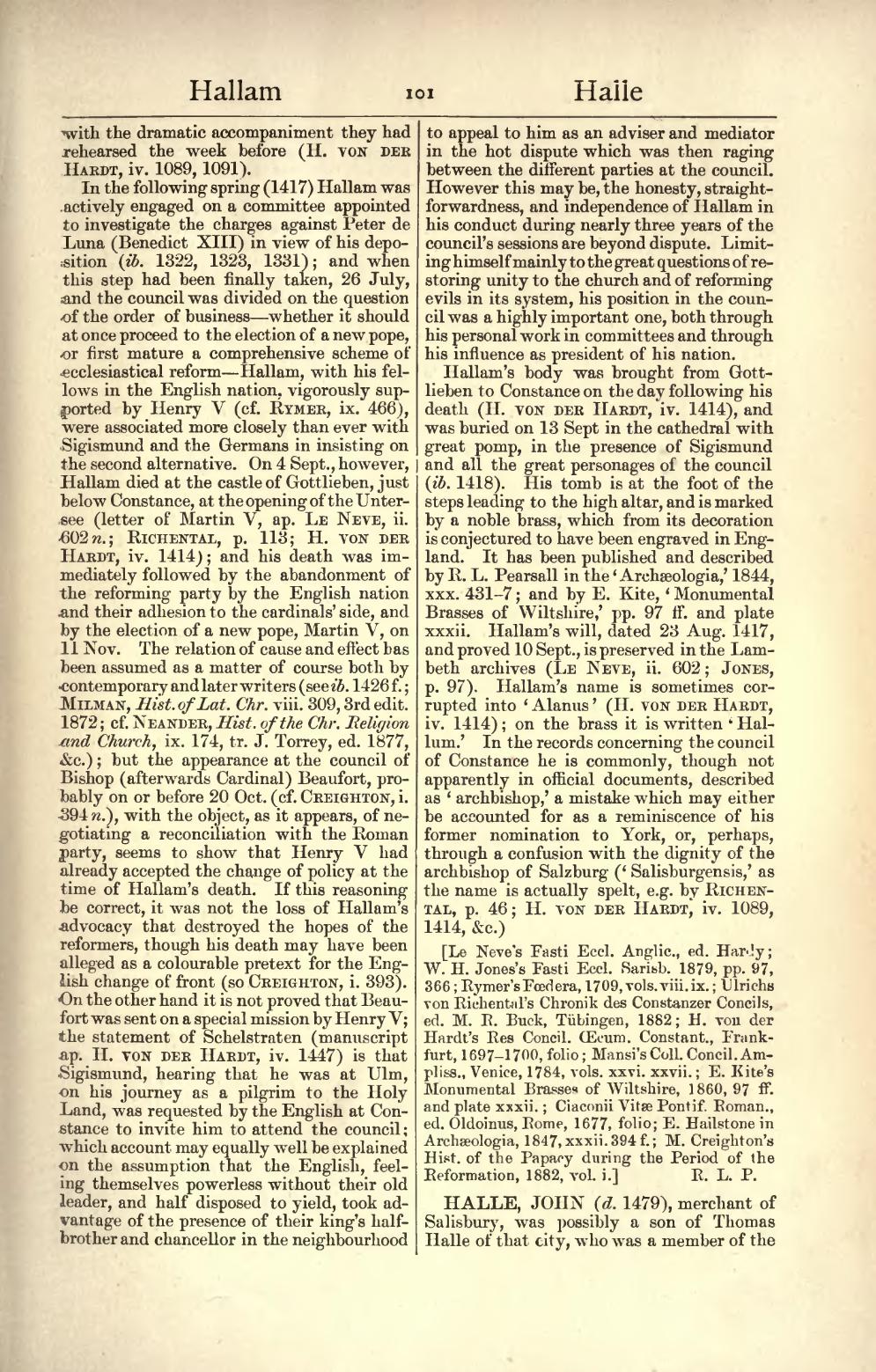with the dramatic accompaniment they had rehearsed the week before (H. von der Hardt, iv. 1089, 1091).
In the following spring (1417) Hallam was actively engaged on a committee appointed to investigate the charges against Peter de Luna (Benedict XIII) in view of his deposition (ib. 1322, 1323, 1331); and when this step had been finally taken, 26 July, and the council was divided on the question of the order of business—whether it should at once proceed to the election of a new pope, or first mature a comprehensive scheme of ecclesiastical reform—Hallam, with his fellows in the English nation, vigorously supported by Henry V (cf. Rymer, ix. 466), were associated more closely than ever with Sigismund and the Germans in insisting on the second alternative. On 4 Sept., however, Hallam died at the castle of Gottlieben, just below Constance, at the opening of the Untersee (letter of Martin V, ap. Le Neve, ii. 602 n.; Richental, p. 113; H. von der Hardt, iv. 1414); and his death was immediately followed by the abandonment of the reforming party by the English nation and their adhesion to the cardinals' side, and by the election of a new pope, Martin V, on 11 Nov. The relation of cause and effect has been assumed as a matter of course both by contemporary and later writers (see ib. 1426 f.; Milman, Hist. of Lat. Chr. viii. 309, 3rd edit. 1872; cf. Neander, Hist. of the Chr. Religion and Church, ix. 174, tr. J. Torrey, ed. 1877, &c.); but the appearance at the council of Bishop (afterwards Cardinal) Beaufort, probably on or before 20 Oct. (cf. Creighton, i. 394 n.), with the object, as it appears, of negotiating a reconciliation with the Roman party, seems to show that Henry V had already accepted the change of policy at the time of Hallam's death. If this reasoning be correct, it was not the loss of Hallam's advocacy that destroyed the hopes of the reformers, though his death may have been alleged as a colourable pretext for the English change of front (so Creighton i. 393). On the other hand it is not proved that Beaufort was sent on a special mission by Henry V; the statement of Schelstraten (manuscript ap. H. von der Hardt, iv. 1447) is that Sigismund, hearing that he was at Ulm, on his journey as a pilgrim to the Holy Land, was requested by the English at Constance to invite him to attend the council; which account may equally well be explained on the assumption that the English, feeling themselves powerless without their old leader, and half disposed to yield, took advantage of the presence of their king's half-brother and chancellor in the neighbourhood to appeal to him as an adviser and mediator in the hot dispute which was then raging between the different parties at the council. However this may be, the honesty, straightforwardness, and independence of Hallam in his conduct during nearly three years of the council's sessions are beyond dispute. Limiting himself mainly to the great questions of restoring unity to the church and of reforming evils in its system, his position in the council was a highly important one, both through his personal work in committees and through his influence as president of his nation.
Hallam's body was brought from Gottlieben to Constance on the day following his death (H. von der Hardt, iv. 1414), and was buried on 13 Sept. in the cathedral with great pomp, in the presence of Sigismund and all the great personages of the council (ib. 1418). His tomb is at the foot of the steps leading to the high altar, and is marked by a noble brass, which from its decoration is conjectured to have been engraved in England. It has been published and described by R. L. Pearsall in the ‘Archæologia,’ 1844, xxx. 431–7; and by E. Kite, ‘Monumental Brasses of Wiltshire,’ pp. 97 ff. and plate xxxii. Hallam's will, dated 23 Aug. 1417, and proved 10 Sept., is preserved in the Lambeth archives (Le Neve, ii. 602; JONES, p. 97). Hallam's name is sometimes corrupted into ‘Alanus’ (H. von der Hardt, iv. 1414); on the brass it is written ‘Hallum.’ In the records concerning the council of Constance he is commonly, though not apparently in official documents, described as ‘archbishop,’ a mistake which may either be accounted for as a reminiscence of his former nomination to York, or, perhaps, through a confusion with the dignity of the archbishop of Salzburg (‘Salisburgensis,’ as the name is actually spelt, e.g. by Richental, p. 46; H. von der Hardt, iv. 1089, 1414, &c.).
[Le Neve's Fasti Eccl. Anglic., ed. Hardy; W. H. Jones's Fasti Eccl. Sarisb. 1879, pp. 97, 366; Rymer's Fœdera, 1709, vols. viii. ix.; Ulrichs von Richental's Chronik des Constanzer Concils, ed. M. R. Buck, Tübingen, 1882; H. von der Hardt's Res Concil. Œcum. Constant., Frankfurt, 1697–1700, folio; Mansi's Coll. Concil. Ampliss., Venice, 1784, vols. xxvi. xxvii.; E. Kite's Monumental Brasses of Wiltshire, 1860, 97 ff. and plate xxxii.; Ciaconii Vitæ Pontif. Roman., ed. Oldoinus, Rome, 1677, folio; E. Hailstone in Archæologia, 1847, xxxii. 394 f.; M. Creighton's Hist. of the Papacy during the Period of the Reformation, 1882, vol. i.]
HALLE, JOHN (d. 1479), merchant of Salisbury, was possibly a son of Thomas Halle of that city, who was a member of the
